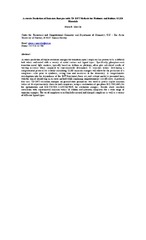| dc.contributor.author | Morello, Glenn Robert | |
| dc.date.accessioned | 2018-03-21T10:09:21Z | |
| dc.date.available | 2018-03-21T10:09:21Z | |
| dc.date.issued | 2017-05-02 | |
| dc.description.abstract | Accurate prediction of triplet excitation energies for
transition metal complexes has proven to be a difficult task
when confronted with a variety of metal centers and ligand
types. Specifically, phosphorescent transition metal light emitters,
typically based on iridium or platinum, often give calculated
results of varying accuracy when compared to experimentally
determined T1 emission values. Developing a computational
protocol for reliably calculating OLED emission
energies will allow for the prediction of a complex’s color
prior to synthesis, saving time and resources in the laboratory.
A comprehensive investigation into the dependence of the
DFT functional, basis set, and solvent model is presented here,
with the aim of identifying an accurate method while remaining
computationally cost-effective. A protocol that uses TDDFT
excitation energies on ground-state geometries was used
to predict triplet emission values of 34 experimentally characterized
complexes, using a combination of gas phase B3LYP/
LANL2dz fo r optimization and B3LYP/CEP -31G/
PCM(THF) for excitation energies. Results show excellent
correlation with experimental emission values of iridium and
platinum complexes for a wide range of emission energies.
The set of complexes tested includes neutral and charged complexes,
as well as a variety of different ligand types. | en_US |
| dc.description.sponsorship | Notur/NorStore: nn9330k | en_US |
| dc.description | This is a pre-print of an article published in Journal of Molecular Modeling. The final authenticated version is available online at: <a href=https://doi.org/10.1007/s00894-017-3348-2> https://doi.org/10.1007/s00894-017-3348-2 </a> | en_US |
| dc.identifier.citation | Morello, G. R. (2017). Accurate prediction of emission energies with TD-DFT methods for platinum and iridium OLED materials. Journal of Molecular Modeling, 23(174). 1-10. https://doi.org/10.1007/s00894-017-3348-2 | en_US |
| dc.identifier.cristinID | FRIDAID 1472446 | |
| dc.identifier.doi | 10.1007/s00894-017-3348-2 | |
| dc.identifier.issn | 0948-5023 | |
| dc.identifier.uri | https://hdl.handle.net/10037/12398 | |
| dc.language.iso | eng | en_US |
| dc.publisher | Springer Verlag | en_US |
| dc.relation.journal | Journal of Molecular Modeling | |
| dc.relation.projectID | info:eu-repo/grantAgreement/RCN/FRINATEK/231706/Norway/"Eeny, meeny, miny, moe": Selectivity-determining factors in asymmetric catalysis// | en_US |
| dc.rights.accessRights | openAccess | en_US |
| dc.subject | VDP::Matematikk og Naturvitenskap: 400::Kjemi: 440 | en_US |
| dc.subject | VDP::Mathematics and natural science: 400::Chemistry: 440 | en_US |
| dc.title | Accurate prediction of emission energies with TD-DFT methods for platinum and iridium OLED materials | en_US |
| dc.type | Journal article | en_US |
| dc.type | Tidsskriftartikkel | en_US |


 English
English norsk
norsk
